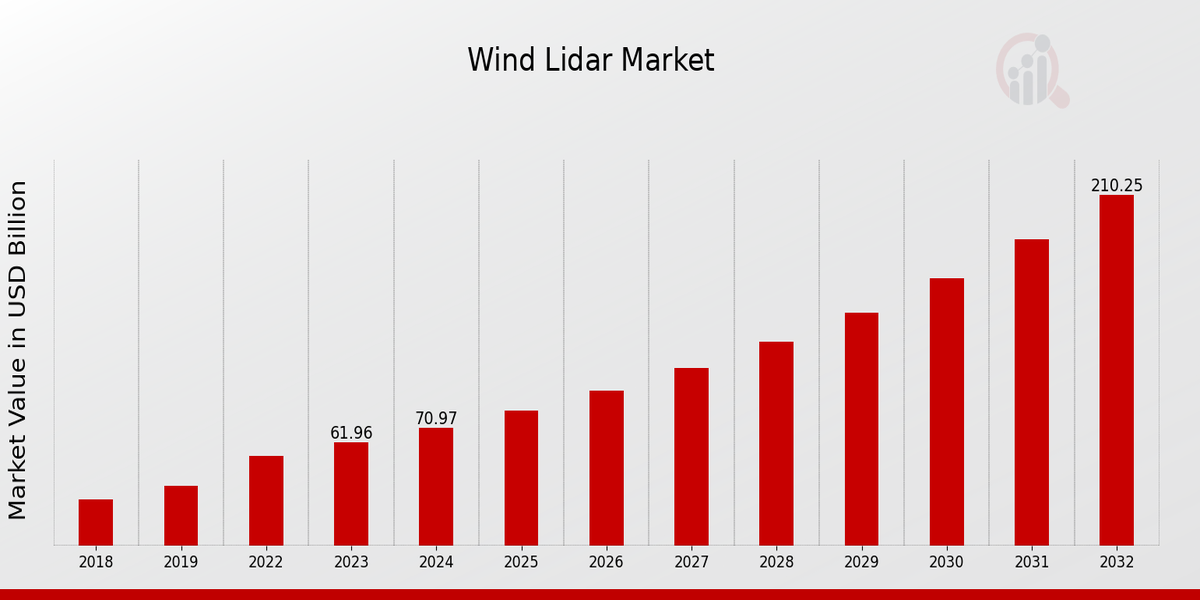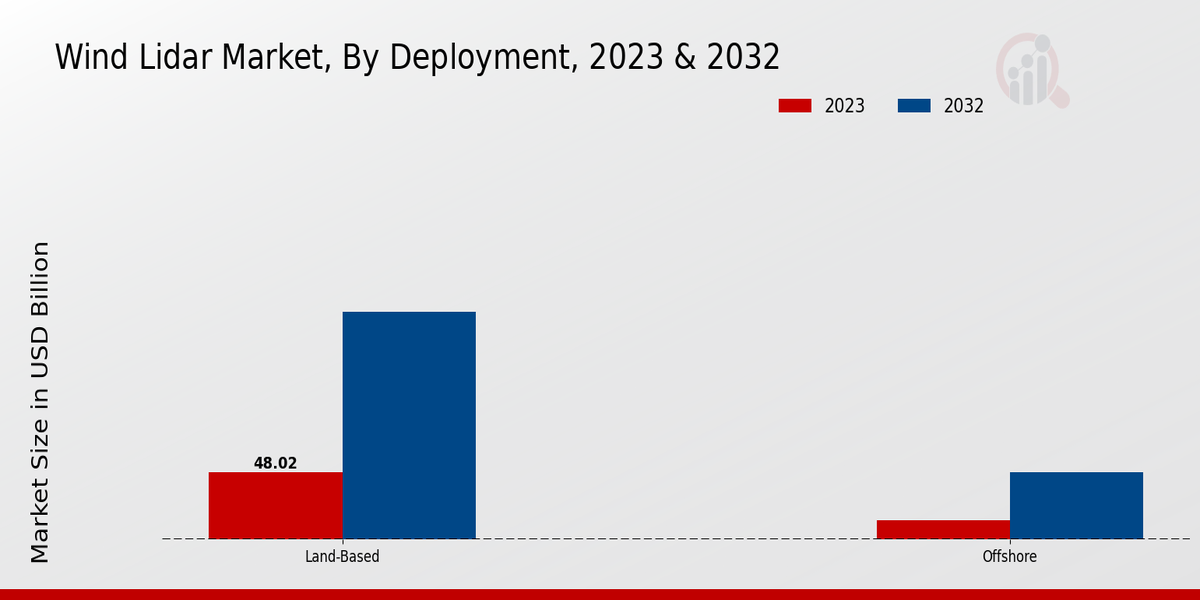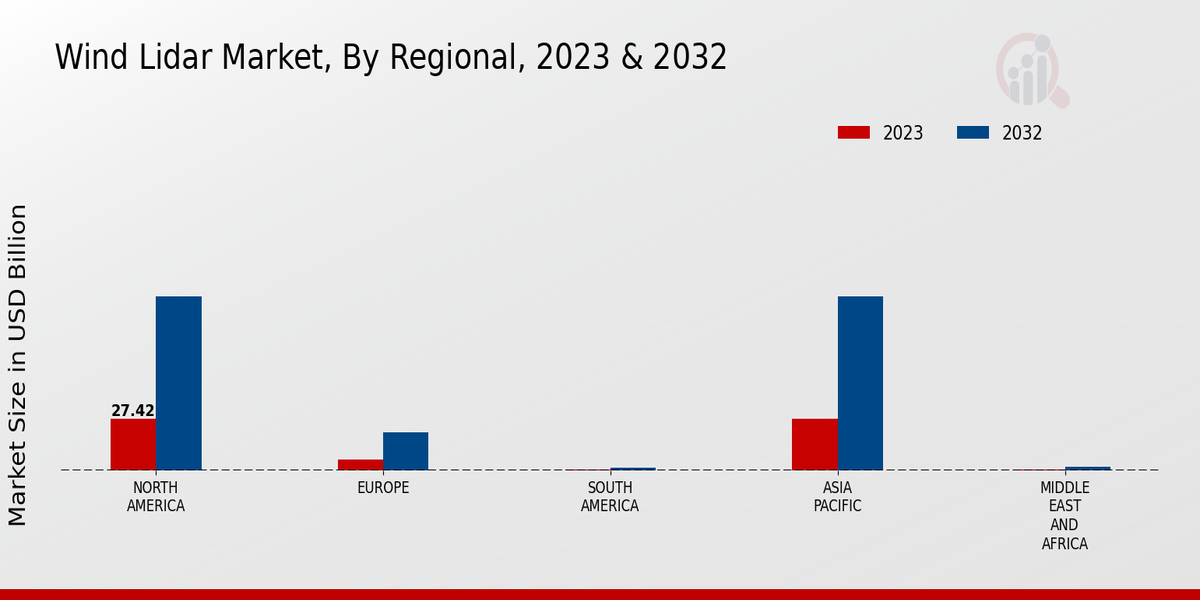Global Wind Lidar Market Overview
As per MRFR analysis, the Wind Lidar Market Size was estimated at 54.1 (USD Billion) in 2022. The Wind Lidar Market Industry is expected to grow from 61.96 (USD Billion) in 2023 to 210.3 (USD Billion) by 2032. The Wind Lidar Market CAGR (growth rate) is expected to be around 14.54% during the forecast period (2024 - 2032).
Key Wind Lidar Market Trends Highlighted
Key market drivers for Wind Lidar include the growing demand for renewable energy sources, increasing wind farm installations, and the need for efficient wind energy forecasting. Governments worldwide promote sustainable energy initiatives, driving investments in wind power generation. Furthermore, technological advancements in Lidar systems, such as improved accuracy and range, enhance wind energy optimization and site assessment capabilities. Emerging opportunities lie in the integration of Wind Lidar data into advanced wind forecasting models, enabling more precise predictions and grid integration.
Additionally, the expansion of offshore wind farms presents new market opportunities for Wind Lidar systems designed for harsh marine environments. Collaboration between Lidar manufacturers and wind turbine original equipment manufacturers (OEMs) is fostering innovation and customized solutions. Recent trends in the Wind Lidar market include the adoption of continuous wave (CW) Lidar technology, which offers higher update rates and data density. Compact and portable Lidar devices are gaining traction for distributed wind resource assessment and mobile applications. Furthermore, the use of multi-beam Lidar systems allows for simultaneous measurements in different directions, increasing data coverage and accuracy. These advancements enhance wind energy project planning, operation, and maintenance practices, driving the growth of the Wind Lidar market in the coming years.

Source: Primary Research, Secondary Research, MRFR Database and Analyst Review
Wind Lidar Market Drivers
Increasing Adoption of Renewable Energy Sources
The main industry driver for the Wind Lidar Market Industry is the ever-increasing demand for wind power, a renewable energy source. Wind lidar systems facilitate the conversion of the wind into electric power, and they do so most effectively when wind conditions are measured accurately. Thus, as the world becomes more focused on clean and renewable energy, governments and businesses across the globe increasingly adopt wind energy sources, resulting in the demand for wind lidar systems in particular to soar. For the time being, the industry benefits greatly from developing markets’ wind energy project undertakings, as these are well on their way to increasing in number.
Technological Advancements and Cost Reductions
Technology is constantly bringing new developments in wind lidar systems, where advancements are reported increasingly focusing on the accuracy, reliability, and efficiency of these systems. These developments arise as a result of new applications in the wind sector, necessitating development for the required accuracy and reliability. Advancements in technologies include new laser sources, chosen based on the criteria of performance and cost, enhanced signal processing, and developments in data analysis capabilities. Technology advancements are leading to the expected reduction of wind lidar system costs, spurring a new range of customers. The combination of technology advancements and subsequent cost reductions promises to drive adoption in the Wind Lidar Market Industry.
Supportive Government Policies and Regulations
Governments around the world are implementing supportive policies and regulations to promote the adoption of renewable energy sources, including wind power. These policies and regulations provide financial incentives, such as tax credits and subsidies, to encourage businesses and consumers to invest in wind energy projects. Additionally, governments are establishing stringent environmental regulations to reduce greenhouse gas emissions, which is further driving the demand for wind lidar systems in the Wind Lidar Market Industry.
Wind Lidar Market Segment Insights
Wind Lidar Market Deployment Insights
The deployment segment of the Wind Lidar Market is divided into land-based and offshore segments. In 2023, the land-based segment dominated the market, and it is expected to continue to do so during the forecast period. This dominance is attributed to the increased adaptability and cost-effectiveness of land-based wind lidars. The land-based wind lidars are usually mounted on towers or other elevated structures; hence, they are easier to install and maintain in comparison to offshore wind lidars. Additionally, land-based wind lidars are less likely to be affected by harsh conditions; thus, they are a more reliable option for wind measurement.
On the other hand, the offshore segment is expected to grow at a higher rate than the land-based segment during the forecast period. This growth is fueled by the increasing installation of offshore wind farms. The offshore wind farms are usually in remote areas; hence, the wind conditions are typically complicated hence the need for wind lidar. In addition, it is anticipated to attain a market value of USD 210.3 billion by 2032. The growth is attributed to the increased adoption of wind energy, the rising demand for renewable energy sources, and the technological advancements in wind lidar technology. Hence, wind lidars are playing a critical role in the wind energy industry as it takes the industry a further step closer to reducing energy dependency while saving the maximum energy costs.

Source: Primary Research, Secondary Research, MRFR Database and Analyst Review
Wind Lidar Market Application Insights
The application segment is one of the most important segments in the Wind Lidar Market. Power Forecasting holds the leading position in this segment, accounting for almost 40% of the market share in 2023. The increased use of renewable energy sources and the inability to compile accurate wind power reports are the factors that drive this segment. Site Assessment is another important application, capturing almost 30% of the market. The growing demand for adequate wind farm development and the need to reach efficient turbine placement is the reason for the development of this segment.
Turbine Operation and Maintenance is responsible for nearly 25% of the market and is experiencing stable growth. The increased focus on wind turbine performance optimization and predictive maintenance is one of the reasons for this growth. All of these applications contribute to the overall growth of the market. The market size is expected to amount to 75.9 billion USD by 2024. The CAGR growth for the market from 2024 to 2032 is expected to reach 15.2%.
Wind Lidar Market Technology Insights
The Wind Lidar Market is segmented by technology into Continuous Wave (CW) and Pulsed. The CW segment accounted for the largest market share in 2023 and is expected to maintain its dominance over the forecast period. CW lidars emit a continuous beam of light and measure the Doppler shift of the backscattered light to determine wind speed and direction. Pulsed lidars, on the other hand, emit short pulses of light and measure the time it takes for the pulses to travel to and from the target to determine wind speed and direction.
The pulsed segment is expected to grow at a faster CAGR over the forecast period due to its higher accuracy and longer range compared to CW lidars. In 2023, the CW segment held a market share of approximately 60%, while the pulsed segment accounted for the remaining 40%. By 2032, it is estimated that the CW segment will hold a market share of 55%, while the pulsed segment will grow to 45%.
Wind Lidar Market Range Insights
The Wind Lidar Market segmentation by range includes short-range, medium-range, and long-range. Among these, the short-range segment is estimated to hold the largest share of the market in 2023 and is projected to continue its dominance throughout the forecast period. This growth is attributed to the increasing adoption of short-range wind lidars for various applications such as wind turbine performance monitoring, site assessment, and wind resource mapping. The medium-range segment is expected to witness significant growth over the forecast period, driven by the growing demand for wind lidars with higher measurement ranges. The long-range segment is expected to grow at a steady pace, as these lidars are primarily used for offshore wind farm applications.
Wind Lidar Market Regional Insights
The Wind Lidar Market's regional segmentation offers insights into its geographical distribution and growth potential. North America is expected to dominate the market with a significant share, driven by increasing wind energy installations and government initiatives to promote renewable energy. Europe is another key region, with a strong focus on offshore wind farms and favorable regulatory policies. The APAC region is anticipated to witness significant growth, attributed to the rising demand for renewable energy in countries like China and India. South America and the MEA region are expected to contribute moderately to the overall market but offer potential for future growth as wind energy projects gain traction in these regions. With the increasing adoption of wind energy globally, the Wind Lidar Market revenue is projected to grow substantially in the coming years.

Source: Primary Research, Secondary Research, MRFR Database and Analyst Review
Wind Lidar Market Key Players and Competitive Insights
The Wind Lidar Market industry is characterized by intense competition among a few major players. Leading Wind Lidar Market players are constantly investing in research and development to stay ahead of the curve and launch innovative products. Some of the key competitive strategies adopted by Wind Lidar Market players include product differentiation, strategic partnerships, and acquisitions. The competitive landscape of the Wind Lidar Market industry is likely to remain competitive in the years to come, with new entrants and niche players emerging in the market. Vaisala, a leading player in the Wind Lidar Market, offers a range of products and services to meet the diverse needs of its customers. The company's Wind Lidar systems are used for a variety of applications, including wind resource assessment, wind turbine performance monitoring, and wind forecasting.
Vaisala has a strong global presence and a well-established distribution network, which enables it to reach customers in all major markets. The company is committed to providing high-quality products and services, and it has a strong track record of innovation.RWE, a global leader in the energy sector, is another major player in the Wind Lidar Market. The company's Wind Lidar systems are used for a variety of applications, including wind resource assessment, wind turbine performance monitoring, and wind forecasting. RWE has a strong track record of innovation and is constantly investing in research and development. The company is also committed to providing high-quality products and services, and it has a strong global presence.
Key Companies in the Wind Lidar Market Include
- Avent
- ZephIR Lidar
- Foth
- Vaisala
- Aeroline
- Eolos
- Halo Photonics
- Leosphere
- 4Wind
- RIEGL
- Nortek
- Windcube
- NRG Systems
- Siemens
Wind Lidar Market Industry Developments
The Wind Lidar Market size was valued at USD 61.96 billion in 2023 and is projected to grow at a CAGR of 14.54% from 2024 to 2032. The market is driven by the increasing demand for renewable energy sources and the need for accurate wind data for wind farm optimization.Recent developments in the market include the launch of new products with advanced features, such as the Vaisala WindCube 400S, which offers high accuracy and reliability in complex wind conditions. Additionally, the growing adoption of digitalization and automation in the wind energy industry is expected to drive the demand for Wind Lidar technology.Key players in the market include Vaisala, Leosphere, Siemens Gamesa, and General Electric. These companies are focusing on strategic partnerships and acquisitions to expand their market presence and enhance their product offerings.
Wind Lidar Market Segmentation Insights
-
Wind Lidar Market Deployment Outlook
-
Wind Lidar Market Application Outlook
- Power Forecasting
- Site Assessment
- Turbine Operation and Maintenance
-
Wind Lidar Market Technology Outlook
-
Wind Lidar Market Range Outlook
- Short Range
- Medium Range
- Long Range
-
Wind Lidar Market Regional Outlook
- North America
- Europe
- South America
- Asia Pacific
- Middle East and Africa
| Report Attribute/Metric |
Details |
| Market Size 2022 |
54.1 (USD Billion) |
| Market Size 2023 |
61.96 (USD Billion) |
| Market Size 2032 |
210.3 (USD Billion) |
| Compound Annual Growth Rate (CAGR) |
14.54% (2024 - 2032) |
| Report Coverage |
Revenue Forecast, Competitive Landscape, Growth Factors, and Trends |
| Base Year |
2023 |
| Market Forecast Period |
2024 - 2032 |
| Historical Data |
2019 - 2023 |
| Market Forecast Units |
USD Billion |
| Key Companies Profiled |
Avent, ZephIR Lidar, Foth, Vaisala, Aeroline, Eolos, Halo Photonics, Leosphere, 4Wind, RIEGL, Nortek, Windcube, NRG Systems, Siemens |
| Segments Covered |
Deployment, Application, Technology, Range, Regional |
| Key Market Opportunities |
1 Increasing demand for offshore wind energy 2 Integration of LiDAR with wind turbines 3 Growing adoption of floating LiDAR systems 4 Favorable government policies and incentives 5 Technological advancements and cost reduction |
| Key Market Dynamics |
Rising wind energy installation technological advancements Government incentives Increased demand for accurate wind data growth in offshore wind energy |
| Countries Covered |
North America, Europe, APAC, South America, MEA |
Frequently Asked Questions (FAQ) :
The Wind Lidar Market is expected to reach a valuation of USD 61.96 billion by 2023, with a projected CAGR of 14.54% between 2024 and 2032. This growth can be attributed to increasing demand for renewable energy sources, particularly wind energy.
North America to record a substantial CAGR during the forecast period and is expected to reach a significant market size by 2032.
Wind Lidar technology finds applications in various aspects of wind energy, including wind resource assessment, turbine performance optimization, and wind farm control. It helps improve the efficiency and profitability of wind energy projects by providing accurate and real-time data on wind conditions.
Prominent players in the Wind Lidar Market include Vaisala, Leosphere, ZX Lidars, Siemens Gamesa Renewable Energy, and RWE. These companies offer a range of Wind Lidar solutions tailored to different applications and wind energy project requirements.
The growth of the Wind Lidar Market is driven by several factors, including rising environmental concerns, increasing demand for renewable energy, and supportive government policies promoting wind energy development. Additionally, technological advancements and cost reductions in Wind Lidar systems further contribute to market expansion.
The Wind Lidar Market is segmented based on various criteria, including technology (continuous wave and pulsed), application (wind resource assessment, turbine performance optimization, and wind farm control), and region (Asia-Pacific, North America, Europe, and Rest of the World).
The Wind Lidar Market faces challenges such as technological limitations in measuring wind conditions in complex terrain and harsh environments. Additionally, stringent regulatory requirements and standards for Wind Lidar systems can impact market growth.
Key trends shaping the Wind Lidar Market include the integration of advanced technologies such as artificial intelligence (AI) and machine learning (ML) to enhance data analytics and forecasting capabilities. Furthermore, the increasing adoption of Wind Lidar technology in offshore wind energy projects presents significant growth opportunities.
The Wind Lidar Market is projected to exhibit a robust growth rate of 14.54% during the forecast period from 2024 to 2032. This growth is attributed to the rising adoption of wind energy worldwide and the increasing need for accurate and reliable wind data for efficient wind energy project development and operation.
Wind Lidar technology has potential applications in various industries beyond wind energy, such as aviation, meteorology, and environmental monitoring. It can be used for weather forecasting, air traffic management, and studying atmospheric conditions, contributing to improved safety and efficiency in these sectors.

















